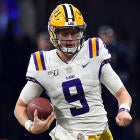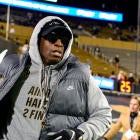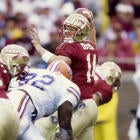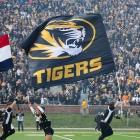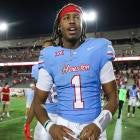The official Heisman Trophy ballot only allows voters to list three players. Seems kind of limiting considering there are 130 schools, half of them in the Power Five, and scores of skill players populating them.
Fortunately, we are not limiting ourselves in this space.
The 2019 season was one in which Ohio State could have made a case for three candidates by itself. Four if you count LSU's quarterback, an Ohio State graduate.
One of the Buckeyes was a defensive force we haven't seen the likes off in at least a decade. Another was picked off once in 308 throws. Still another made himself one of the all-time runners at Ohio State, a school that can brag a bit about all-time runners.
But none of them measured up to LSU QB Joe Burrow. A kid whose dad and brothers played at Nebraska; a kid who grew up in Ohio and played at Ohio State before finding his game in the Bayou.
What a season. Here is how my Heisman ballot would look.
1. Joe Burrow, redshirt senior quarterback, LSU: A combination of maturation, coaching, talent and a new offense produced the nation's best player. His story captured the nation. His game wore down opponents. Burrow went from being "just a guy" (in 2018, per CBS Sports draft analyst Ryan Wilson) to the best quarterback in LSU history. Burrow took to Joe Brady's spread scheme as a thrower, a runner and a leader. With two more touchdowns in the College Football Playoff, he will become the seventh quarterback in history to throw for 50 scores.
2. Justin Fields, sophomore quarterback, Ohio State: A truly historic season for the former No. 1 national recruit. In an offense that evolved into a power running unit, Fields tossed 40 touchdowns against only one interception. He added 471 yards and 10 more touchdowns on the ground. No quarterback in at least the last 11 years has combined such production with that kind of efficiency. Talk about realized potential. This is what Georgia expected Fields to be but couldn't afford to give him enough time behind Jake Fromm.
3. J.K. Dobbins, junior running back, Ohio State: In the last three games, Dobbins became a work horse carrying the ball a combined 100 times. He went from averaging 18 carries in the first 10 games to more than 33 in the final three. Chasing Wisconsin's Jonathan Taylor (see below) motivated him. An engine drove him. "I'm not even close to being satisfied," he said after the Michigan game. After 172 yards against Wisconsin, Dobbins is now the No. 2 rusher in Ohio State history behind only Archie Griffin. If you're going to beat the Buckeyes in the playoff, you have to stop Dobbins first.
Honorable mentions
- Chase Young, junior defensive end, Ohio State: The only reason Young didn't make it into my top three is he was skunked against Michigan (no tackles) and missed two games because of the NCAA suspension. Otherwise, "The Predator" was a beast. Go ahead and crown him the national defensive player of the year.
- Jalen Hurts, senior quarterback, Oklahoma: What a career. Four years, two teams, four playoff appearances. Hurts reinvented himself at Oklahoma where coach Lincoln Riley maxed out his true potential. If it wasn't for his niggling habit of turning the ball over, Hurts would be in the top three.
- Chuba Hubbard, redshirt sophomore running back, Oklahoma State: From playing CFL rules in high school in his native Canada to dominating the Big 12 and the nation at Tailback U, Hubbard was the most productive back in the country. Take a good look, the redshirt sophomore is likely headed to the NFL. With 1,936 yards, Hubbard needs 219 in the bowl game to become a top 10 all-time single-season rusher.
- Jonathan Taylor, junior running back, Wisconsin: A credit to his family, Wisconsin and college football, Taylor will go down as one of the best backs in Big Ten history. Already over 6,000 yards in his career, Taylor is within a monster bowl game of catching Donnell Pumphrey to become the NCAA's career rushing leader. Just don't tell Wisco legend Ron Dayne. The NCAA didn't count Dayne's bowl games back in the day.












